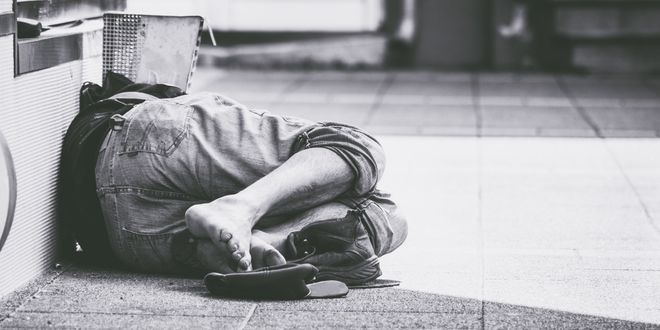Both Riverside and San Bernardino counties are claiming progress in their efforts to reduce their homeless populations, according to data released this month.
Riverside County identified 3,990 people who were living in a homeless shelter or on the street during its annual Point-in-Time Count, which county officials and a team of nearly 900 volunteers conducted Jan. 22, according to a statement on the county’s website.
While that did represent an increase of 265 homeless individuals compared with the county’s 2023 count, it did slow the growth of homelessness countywide, which continued a recent trend: down 15 percent in 2022, 12 percent in 2023 and seven percent this year.
Riverside County did not conduct a count in 2024.
Perhaps most importantly, this year’s count recorded a 19 percent reduction of people who were living on the street, a category known as unsheltered homeless. Also, four groups that often experience homelessness – veterans, seniors, young people, and families with children – recorded “significant” population drops in Riverside County last year, according to the count.
“It is tremendous progress that we have huge reductions, less people living on the streets and more people having access to shelters,” said Supervisor V. Manuel Perez in the statement. “By targeting the root causes of homelessness and expanding access to housing and care, we are helping more residents find stability and hope.”
Riverside County has also experienced a 57 percent increase in shelter beds since 2023, but the big news in this year’s report was the data regarding unsheltered homeless individuals, according to Heidi Marshall, director of the county’s Department of Housing and Workforce Solutions.
“The number of people living in shelters (2,012) was an 11 percent increase, but that’s actually a good thing,” Marshall said. “We want the sheltered (percentage) to go up, because it means people are getting into the system and are getting help, and we want the unsheltered percentage to go down.”
The annual nationwide Point-in-Time Count is conducted by local agencies called Continuums of Care. It is done at the behest of the U.S. Department of Housing and Urban Development, which uses the data from the counts to determine how effectively local governments are dealing with their homeless populations, and how much federal funding they should receive.
HUD also incorporate their data into the Annual Homeless Assessment Report, which is presented to Congress.
The count, which was started because homeless people were often overlooked in the regular U.S. Census, happens on one evening during the last 10 days in January, unless another date is approved by the department. It is considered a snapshot of the homeless population in a particular area, but it can be less than accurate because homeless people can be difficult to find, and they’re often not cooperative when they are found.
Nevertheless, the Point-in-Time count – which was first held in 2005 – is crucial for cities and counties when they’re trying to secure grants to help reduce their homeless populations.
In San Bernardino County, 2,718 individuals were identified as unsheltered homeless, a year-over-year drop of 14.2 percent, according to a statement released by the county.
This year’s count, which was conducted Jan. 23, found a decrease of 435 unsheltered individuals compared with 2024’s count. This year’s count marked a major change from the past three years: in 2024, San Bernardino County’s homeless population grew by one percent, by 26 percent in 2023 and 6.6 percent in 2022.
The city of San Bernardino generated headlines last fall when it began, for the second time, removing homeless encampments from its parks. That action became possible after a lawsuit that stopped the city’s first park cleanup was settled.
That suit, filed by the ACLU, alleged mistreatment of the people being removed, including destroying or misplacing their personal property, and not arranging adequate shelter for people with disabilities.
Anyone removed from one of San Bernardino’s Park is considered unsheltered, a distinction that people should make when they’re assessing any homeless statistics, Councilman Theodore Sanchez said.
“You have to look at more than the total number of homeless, because there’s a big difference between a sheltered person and an unsheltered person,” Sanchez said. “A person could be about to leave a shelter and start earning a living, which is not the same thing as someone who is literally living on a sidewalk.
They are both counted as homeless, but I think you have to break those numbers down to get a clear picture.”
San Bernardino’s Park clean-out is ongoing, and probably won’t be finished soon.
“It’s going well, but it’s an ongoing effort,” Sanchez said. “It’s not like we get homeless people out of the parks, and then everything goes back to normal. We have to work to keep them from coming back.”
It’s also a mistake to put too much emphasis on one year, said Tanya Tomo, Riverside County’s deputy director of housing and workforce solutions.
“We are interested in trends,” Tomo said. “You can have one good year, or one bad year, but either way that might not tell you anything. You want to see a trend, and right now our numbers are moving in the right direction.”
Eighty percent of the homeless people who get permanent housing after being helped by Riverside County do no not return to living on the streets, according to Tomo.
“We’re very proud of that number,” Tomo said.
 IE Business Daily Business news for the Inland Empire.
IE Business Daily Business news for the Inland Empire.


